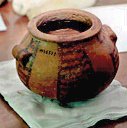Thursday, May 08, 2003
The ancient and, for now, broken Golden Harp of Ur has vanished altogether from this morning’s curious Washington Post and New York Times reports on the Iraq Museum.
Recovered

Oldest known example of a
hand-modeled clay pot
Gone too is Marine Colonel Bogdanos, the P. Diddy prosecuting District Attorney who studied the recently recovered oldest hand-modeled clay pot in graduate school, replaced by “a spokesman for the Homeland Security Department, Dean Boyd” in the Post and “Michael J. Garcia, acting assistant secretary of the Bureau of Immigration and Customs Enforcement, an investigative arm of the Department of Homeland Security” in the Times.
Both stories contradict yesterday’s reporting regarding the “storage vaults” in and around the Iraq Museum by saying that certain vaults have been opened.
The Times:
The investigators located the vaults in Baghdad over the last week, including five within the museum complex, and forced them open, revealing hundreds of artifacts that had apparently been stored away to protect them from being damaged in an American assault. The finds included ancient jewelry, pottery and sarcophaguses, officials said.
The Post:
… These (underground vaults) were breached by agents and U.S. military personnel, the statement said, and many more objects were recovered…
The Post report neglects to mention the vaults holding the Museum’s gold trove under the wreckage of the Iraqi Central Bank. The Times says this in the second to last graph of the story:
Officials said the investigators are following up on reports that many artifacts are stored in several vaults beneath the headquarters of the Iraqi Central Bank in Baghdad.
The news focus is clearly now on the happy aspects of American-assisted undamaged object recovery. The broken Harp of Ur and an earnest Marine no longer fit a story profile that now has Homeland Security involved from the start of looting shortly after Baghdad's fall.
The Post:
A statement from Homeland Security's Bureau of Immigration and Customs Enforcement said its agents and U.S. forces opened an investigation at the National Museum when they heard news of the looting.
The Times is a tad more forthcoming while peaking further unquenched curiosities:
American officials said the new Homeland Security Department… dispatched several agents to the Middle East in the weeks before the American invasion of Iraq…searching for Iraq's chemical and biological weapons and in tracking down assets of Saddam Hussein…After the first reports of looting at the museum…the customs agents shifted their focus to the hunt for those artifacts.
Interesting, huh, how guys go from hunting WMD to antiquities right after Baghdad fell? And, just who's Homeland is being secured, huh?
Both stories have very little information about the high-value items that disappeared early in the looting saga and whose status would be the focus of any journalism class news report.
Buried in the seemingly too succinct Post:
…Authorities have identified 38 missing items classified as high value…
And, buried in the Times:
The teams of investigators… did not provide a detailed inventory of the items that were found in the underground vaults this week, nor would they say if the artifacts included any of the 38 high-value items that had been confirmed missing by museum administrators.
So, it seems after all the hoo-haw, happy spin and Homeland Security involvement, we have information that advances very little from that contained in yesterday’s Associated Press report. And, we are told nothing about a 4,450 year old eleven string wooden harp and its delicate inlays of shell, precious stone and gold that the closing paragraphs of yesterday's AP report said was found broken amid the debis littering the Museum floor. Curious.
Photo: Agence France Presse

